Lisa Dawn's Blog: The Princess Blog, page 4
June 29, 2025
Review: Snow Bound
Snow Bound by CJ Brightley is the latest ARC I've read from the multi-author All That Glitters series of fairy tale retellings. It retells the story of "East of the Sun and West of the Moon," which can be challenging to adapt. The author does a great job of avoiding the pitfalls of the original fairy tale while remaining true to its essence. All the main plot points are present, including the polar bear that turns human at night, the peasant girl who must break the curse, and the wicked goblin queen. The story eliminates the elements of forced marriage and broken promises, which makes the romance more acceptable. Aside from a few gratuitous violent scenes, it's a pleasant retelling of the original fairy tale.
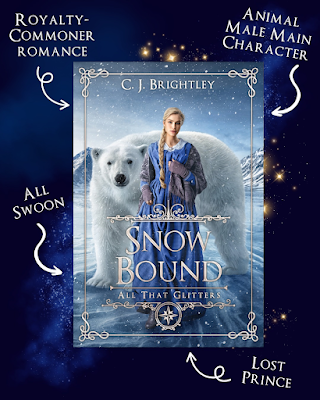
Gytha's family is starving and may not survive the winter if not for the help of a magical polar bear named Alexander. Since Gytha is the only one who can understand Alexander, she must convince her family that he does not wish them harm. Inspired by her courage and kindness, Alexander makes a proposition to Gytha for her to sleep next to a mysterious man in a dark room whom she cannot look at. Upon agreeing to this task, Gytha meets a wicked queen and the many servants she has enslaved. The queen tries to convince Gytha to break her promise by looking at the man who sleeps next to her, but she has a strong hunch that the man is really Alexander. She remains steadfast in her loyalty to him and learns a terrible secret that puts it to the ultimate test.
The original version of "East of the Sun and West of the Moon" has several problematic elements. Yet, I've found many retellings of it enjoyable because they successfully remove or explain away these elements. This book does so by omission. Instead of being forced to marry the polar bear, Gytha must simply live with him for a set period while he sleeps next to her in human form. Instead of betraying his trust, which is a wicked act for a fairy tale protagonist to do, the wicked queen does so instead. There is also a lot of strong worldbuilding with the goblins and their broken kingdom that other adaptations tend to overlook. The book establishes that not all goblins are evil and gives them a rich culture and history.
While I enjoyed many aspects of this novel, I found parts of it unnecessarily violent for a clean fairy tale romance. There was an unnecessarily descriptive scene about preparing an elk for dinner that the polar bear killed for Gytha's family that would send most vegetarians running. A couple of other surprisingly violent scenes are peppered throughout the otherwise calm narrative for emphasis on the villain's wickedness and the goblins' culture. Despite this, it is a pleasant story overall. None of the main characters suffer many hardships, which makes it a light and easy read after acknowledging the trigger warnings. The romance is established early on and remains strong throughout the book.
Snow Bound is a pleasing retelling of "East of the Sun and West of the Moon" that thoughtfully adapts the original tale to create a sweet and engaging romance. By omitting problematic elements and adding depth to the goblin world, CJ Brightley has crafted a story that is both faithful to the source material and fresh in its approach. While the inclusion of gratuitous violence may not be to every reader's taste, the book's lighthearted tone and strong romance make it an enjoyable read overall. Fans of fairy tale retellings and romance will find Snow Bound to be a delightful addition to the All That Glitters series.June 24, 2025
What Do Shirley Temple and Shelley Duvall Have in Common?
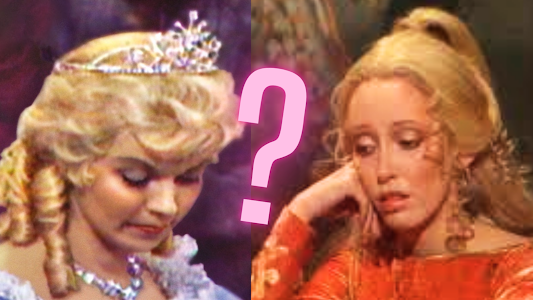
Shirley Temple's Storybook premiered in 1958 when television was still a fairly new medium. Shirley Temple's talents were mostly used by Hollywood directors and producers when she was a child, so she had more creative freedom to take her years of filmmaking experience in any direction she wanted as an adult. Having had her taste of fame and opulence, the young starlet did not stray from the self-indulgence of producing her own series. The opening of each episode shows a glittering wall of jewels, followed by an introduction from the beloved hostess herself in a long, glamorous gown. The show had 29 episodes, though only a little over half of them are still available to watch today. Shirley Temple's Storybook is an appropriate title as the stories range all across the board from fairy tales to classic novels to Native American legends. Shirley took the spotlight in some of the stories and brought out her inner princess in the first live-action interpretations of "The Princess and the Goblin" and "The Little Mermaid."
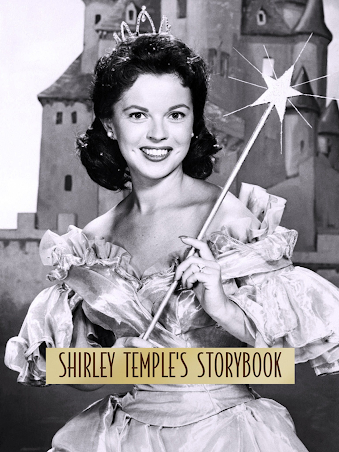
Almost twenty-five years later, Shelley Duvall followed in Shirley Temple's footsteps with Faerie Tale Theatre in 1982. This series was more streamlined than Shirley Temple's Storybook, focusing exclusively on fairy tales as the title suggests. The show featured some big celebrity guests such as , , , and Shelley Duvall herself, who starred as Rapunzel and the miller's daughter in "Rumpelstiltskin." While there was some overlap with Shirley Temple's Storybook, including "Beauty and the Beast," "Rapunzel," "The Little Mermaid," and "Rip Van Winkle," Faerie Tale Theatre also brought many lesser-known stories into the public eye, including "The Princess Who Never Smiled" and "The Story of a Boy Who Went Forth to Learn Fear." Like Shirley Temple, Shelley Duvall personally introduced each story and loved to dress up, though her outfits were more costumey than Hollywood glam. Although some of the stories, such as "The Three Little Pigs" and "Goldilocks and the Three Bears," were embellished to fill the hour-long runtime, they were always fun and entertaining.
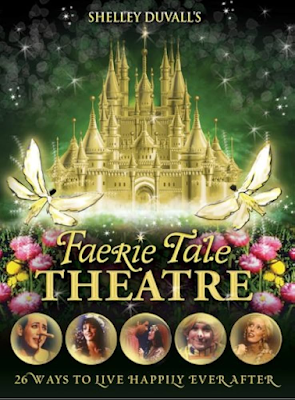
I'm not a fan of competition, but if I had to pit these two series against each other, I would give the prize to Shelley Duvall every time. Faerie Tale Theatre not only has a more specific focus compared to Shirley Temple's Storybook, but Shelley Duvall also did a better job of keeping the stories interesting throughout their lengthy runtimes. Shirley Temple's Storybook often took a long time before any interesting would happen. Shirley Temple would come back every few minutes to introduce Act 2 or 3 of each story when hardly anything had happened in Act 1. Faerie Tale Theatre, on the other hand, used creative embellishments to keep its shorter source material more interesting, such as adding a female pig to "The Three Little Pigs" or casting as "Sleeping Beauty" to show off some of her powerhouse singing. The one thing I will give Shirley Temple's Storybook credit for is its detailed and elaborate costumes from various cultures and periods. I particularly liked the dresses she wore as Princess Irene for "The Princess and the Goblin," and Ozma in "Legends of Oz."
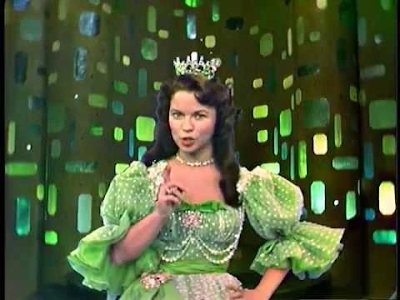
Both Shirley Temple's Storybook and Shelley Duvall's Faerie Tale Theatre are treasured examples of live-action fairy tale adaptations that have captivated audiences with their unique interpretations and star-studded casts. While both series have their strengths and weaknesses, Faerie Tale Theatre stands out for its focused approach to fairy tales and ability to keep stories engaging throughout their hour-long runtimes. With its blend of classic and lesser-known tales, Faerie Tale Theatre is a must-watch for fans of fairy tales and nostalgia. Shirley Temple's Storybook, on the other hand, is worth exploring for its elaborate costumes and historical significance as a pioneering effort in television storytelling. Both series are a testament to the enduring power of fairy tales to enchant and inspire audiences of all ages.
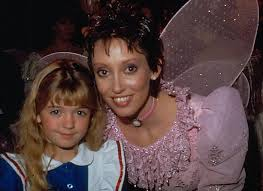
June 22, 2025
Review: Feathered Thief
At this point, I've read over half the books from the All That Glitters multi-author series of fairy tale retellings. The newest release in this series is Feathered Thief by JM Stengl, a retelling of an obscure Brothers Grimm fairy tale called "The Golden Bird." It is an interesting and creative take on the story and incorporates a romance spanning many years. My biggest struggle with this book is that one of the characters has their memories altered, which is a trope that I've struggled with in other books I've read in the past. The beginning and ending of the book are straightforward and romantic, but the middle portion can get murky at times. Regardless, it's a magical tale that is filled with enchanting and whimsical imagery. How can you not fall in love with this gorgeous artwork by Jenelle Hovde?
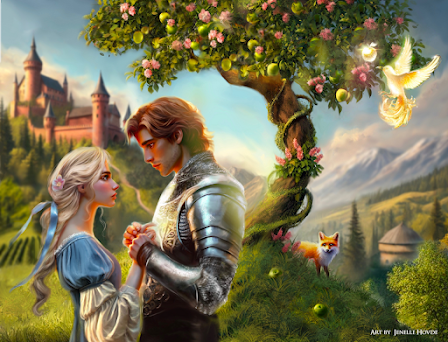
Prince Kazik has known since childhood that he wants to be with Princess Helena. It's too bad he doesn't know how to express that desire without teasing her, as children are prone to do. It takes years for him to learn how to express his feelings more effectively. Helena is confused by his childhood pranks, but comes to care for Kazik as well. The two could not be happier when their families arranged a marriage alliance between them. However, complications strike, and they find themselves in the middle of a twisted game created by a magical entity just beyond their reach. Can they outsmart a bumbling mage, a witty fox, and other magical creatures?
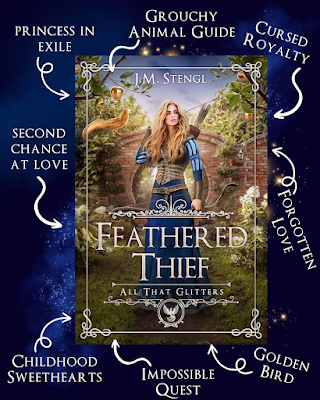
This story starts out simple and gets complicated so quickly that it's like falling into a rabbit hole. Helena and Kazik are all in on their marriage prospects until rumors circulate that their parents have changed their minds. Their response to these rumors has lasting effects for themselves and their kingdoms. Helena's memories are erased, putting her in a fugue state where she doesn't know who she is but understands that she must pass a series of trials for the sake of her kingdom. When his people fall into a magical sleep, Kazik must find Helena and help her restore her memories. They must also figure out if their magical guides are trustworthy to successfully claim their prize.
Although the book strays from the original fairy tale, this book has all of the lovely imagery and whimsy that made the Brothers Grimm so beloved for over a century. There is an enchanted golden apple tree, a sly talking fox, an enchanting golden bird, and a beloved steed that is smarter than it lets on. There are times when the story doesn't make a lot of sense, but when it comes to the magic and wonder that fairy tales bring, it doesn't always need to. Helena and Kazik's selflessness shines through, leading them to great rewards. The satisfying ending makes the mind-bending trials and tribulations all worth it.
Feathered Thief is a charming and imaginative retelling of "The Golden Bird" that will transport you to a world of magic and wonder. With its beautiful imagery, whimsical creatures, and sweet romance, this book is a delightful addition to the All That Glitters series. While the memory alteration trope may be a bit of a stumbling block for some readers, the story's enchanting moments and satisfying ending make it well worth the journey. If you're a fan of fairy tales, romance, and adventure, Feathered Thief is definitely worth checking out.June 20, 2025
You Can Now Watch Frozen The Musical at Home!
For the last thirty years or so, Disney on Broadway has been protective of their live shows, encouraging fans to come to New York City and watch them with their families at high costs. A lot of things changed during the COVID lockdowns. For one, it has become more common for professional recordings of live theater to be made available for people to watch in the comfort of their own homes. In 2020, Disney shared their proshot of Tangled: The Musical, which had previously only been available on their cruise ships. They also tested the waters by releasing a proshot of the record-breaking Hamilton on Disney+. The lockdowns may be over, but their effects have had lasting changes on the media, making it more common than ever to watch live theater from home. The most recent example of this is their West End proshot of Frozen: The Musical, which is available to stream starting today on Disney+.
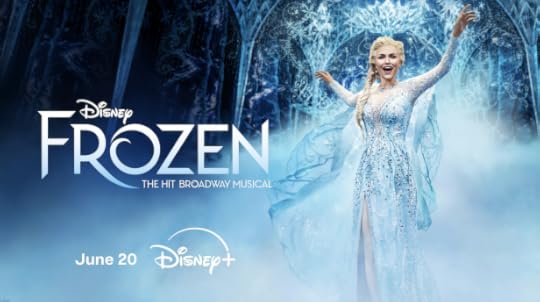
I have my issues with the Frozen movie, but in my opinion, the stage show is the best adaptation that Disney on Broadway has ever done. It's comfortably paced, isn't afraid to get a little dark despite being a children's production, and goes above and beyond with its dazzling costumes and sets. If there were only one Disney on Broadway show I would recommend for home viewing, this would be it. This recording was filmed in England's West End as opposed to Broadway, but the show is virtually identical, and the actors speak with American accents. The performances were on par with the performance I saw live, though I thought the guy who played Hans was a little too goofy to take seriously, especially considering the sharp turn his character makes at the end of the show.
This recording is slightly shorter than the original stage show. The only scene that I noticed was missing was the controversial nude "Hygge" dance, which I doubt anyone missed. Like most proshots, it uses multiple cameras and angles to give at-home viewers as close an experience to being in the theater as possible. Some shots showed the whole stage, while others peered behind he actors to overlook the audience beneath the stage. Overall, the editing was fine, but I have seen better. Some of the audience shots got distracting when I was trying to enjoy the story, and kept getting reminded I was watching a play. It was also a weird choice to have text appear onscreen indicating the end of Act 1 and the beginning of Act 2 when there was no entr'acte in between, since the filmed version has no intermission and could be paused at any time. Besides, everyone knows "Let It Go" signifies the end of the first act.
This recording sufficiently captured the magic of Elsa's dress transformation, the creativity of the puppets used for Olaf and Sven, and the grandeur of the royal and wintry sets. Having also seen the show live, I observed that it's harder for cameras to capture the glitzy sparkles reflecting off the beaded icicles on the stage and Elsa's dress than with the bright stage lighting. The sparkle effect was still visible on camera, but it wasn't as dazzling as in real life. Overall, this recording comes pretty close to seeing the show live. Frozen fans watching the musical in this format for the first time are unlikely to be disappointed. The proshot even uses footage during the end credits to enhance the "live" experience with shots from behind the scenes, including the actors interacting with groups of little girls in costume.
The Disney+ proshot of Frozen: The Musical makes the show more accessible to fans of the stage show and the movie alike who may lack the budget or resources to travel. With its stunning costumes, sets, and beautifully paced storytelling, this recording brings the magic of the West End to your living room. While some aspects of the proshot, such as the editing and camera angles, may not be perfect, the overall experience is relaxing and enjoyable. The emotional story resonates with audiences of all ages and does not pander to children like some of Disney on Broadway's earlier productions. If you're a fan of Frozen or live theater in general, this proshot is definitely worth checking out.June 18, 2025
Review: A Baker's Tail
A Baker's Tail is the latest free book in Kae-Leah Williamson's series of mermaid-themed fairy tale retellings on Wattpad. I've been reading these stories since the beginning, and they are whimsical, inclusive, and a lot of fun. This one is loosely based on "Swan Lake." It takes place in a Russian-inspired fantasy kingdom with many references to real fairy tale contributors. This is Kae-Leah's most inclusive story yet in terms of characters with real disabilities. Odette has a consistent stutter, and Prince Siegfried has a learning disability similar to dyslexia. The story demonstrates that everyone deserves to live out their fairy tale dreams, regardless of who they are.
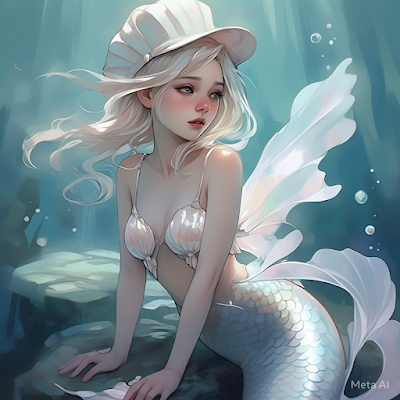
The first six chapters of A Baker's Tail focus on the romance between Odette's parents, Angelica Tschaikovsky and Pavel Lebdev. The extended prologue, which takes up roughly a fifth of the book, is a welcome addition that offers a charming love story with arguably better pacing and development than even the book's main couple. Angelica is a lost princess who runs away from her noble lineage to escape an arranged marriage to a dangerous tyrant. She seeks shelter with an extended relative at a bakery where she falls in love with a baker named Pavel. Their romance grows organically, as well as their family. When Odette is a little girl, Angelica becomes pregnant again. What was meant to be a therapeutic walk along the beach turns violent when Angelica is swept away by the ocean during a freak storm, leaving Odette an orphan.
The ties to "Swan Lake" are apparent, but the transformation into a mermaid instead of a swan is a big diversion from the original story. Instead of being isolated on a lake by day, she is thrust into an entirely new world under the sea and meets many characters from other works in this series. It would have really brought the story full circle to have Odette fall in love with a merman despite her fear of the ocean. The romance takes place on land with a prince named Siegfried, after the original ballet, who falls in love with Odette after visiting her family's bakery. This makes the underwater scenes come off as extraneous at times. However, Odette's exploration of the mermaid kingdom helps her to overcome her fear of water, giving the book an overall theme of healing after trauma.
Odette's transformation by the wicked Rothbart and Siegfried's forced love for Odile are both caused by the Ruby of Rusalka, an enchanted relic with some unusual rules attached to it. When used by a man, it turns its target into a mermaid by night, and when used by a woman, it can force its target to fall in love with her. It is not explained why these abilities change based on the user or why its powers are so specific. Regardless, both Odile and Rothbart make good use of it, but Siegfried is not affected in the way that Odile hoped. His feelings for Odette shine through the ruby's brainwashing, allowing the couple to have a better ending than the original ballet.
A Baker's Tail is a delightful addition to Kae-Leah Williamson's series of mermaid-themed fairy tale retellings, offering a fresh and inclusive take on the classic "Swan Lake" tale. With its charming characters, engaging storyline, and themes of self-discovery and acceptance, this story is sure to captivate readers of all ages. The extended prologue provides a lovely backdrop to the main story, and the underwater world adds a unique twist to the traditional fairy tale narrative. Despite some minor inconsistencies with the Ruby of Rusalka's powers, the story's heart and message shine through, making it a must-read for fans of fantasy and romance.June 15, 2025
Review: Rose Crown
Rose Crown by Nina Clare is a retelling of "Snow White and Rose Red" from the multi-author All That Glitters series. Although I've lost track of how many books I've read from this series, this one was a lovely addition. It covers a lesser-known and rather odd story that doesn't get adapted frequently, and turns it into a beautiful, dream-like tale. The book takes place in the faerie and human realms and includes some of my favorite tropes, such as a lost princess and mermaids. It borrows just enough content from the original fairy tale to feel like a true adaptation while adding enough original elements to feel fresh and new. The cottagecore and fae imagery throughout the book gives it an overall sense of wonder and nostalgia.
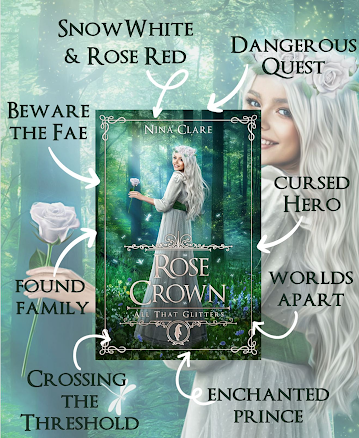
Lily and Rose live in a cottage in the woods at the edge of the gateway between the faerie and human realms. Their mother has an unprecedented amount of magical knowledge for their humble upbringing and provides guidance to keep them safe in their cozy haven. Lily's best friend is a fae bear she rescued from a trap and nicknamed Beran. Her life turns upside down when their quiet home is invaded by two treasure hunter brothers named Jack and Jory, and Rose is kidnapped by a mysterious fae. Without her Beran or her mother to guide her, Lily must trust a group of strangers to journey into the fae realm to recover her lost family. She discovers many secrets about their past along the way.
This book does not contain much budding romance, but there is an abundance of male companions. I spent way too much time trying to figure out who was going to end up with whom. Jack and Jory provide endless comedic relief with their morally grey antics while Sir Oswain is a paragon of chivalry and honor. All three men are seeking the crown of the lost prince and the treasure that goes with it, but take a detour to help Lily on her quest to recover Rose. Many of the implied love interests are red herrings since the book ends similarly to the fairy tale, but I won't spoil it for those who are not familiar with it. There are also some fun animal sidekicks, a magic lamp, and mermaids!
The appeal of this book lies more in the world than it does in the story itself. If you are a fan of fairy tales, princesses, and magical girly aesthetics, this book is a comforting escape from the real world. There are so many unexpectedly welcome tropes from various princess stories that pop up throughout the book. The world is similar to the comforting landscape of Sofia the First or Princess Gwenevere and the Jewel Riders, and is full of surprises and enchantment. As she travels through this whimsical landscape, Lily learns the truth about where she came from and discovers her true potential.
Rose Crown is a charming and enchanting retelling of "Snow White and Rose Red" that will transport you to a whimsical world of faeries, magic, and wonder. With its dreamy cottagecore aesthetic, lovable characters, and exciting adventures, this book is a perfect escape for fans of fairy tales and princess stories. Nina Clare's adaptation skillfully weaves together familiar tropes and original elements, creating a fresh and captivating narrative that will delight readers of all ages. If you're looking for a lighthearted, feel-good story with a touch of magic, Rose Crown is a must-read.June 14, 2025
Story Saturday: The Prince's Servant
When she walked through the narrow path surrounded by neatly trimmed hedges, she saw a bustling crowd of servants frantically preparing orders for food, performers, and decorations for the upcoming ball. She tried to ask them who was in charge of tasks, but most of them were too busy to even notice her. As she dodged several servants carrying large boxes, she finally noticed one woman whom everyone seemed to be reporting to. The woman had sleek golden hair and a gentle demeanor.
"Hello. My name is Lana, and I was hoping to find work here to help my family."
The woman smiled warmly at her. "Oh, you poor dear. I'm sure we could find something for you to do around here. I'm Maizie."
Maizie led Lana into the grand ballroom. It was overwhelmingly large with windows that rose ten stories high to a domed ceiling and a marble-patterned floor. It was also overwhelmingly empty. It was clear that the servants had been so busy with their preparations that no one had time to set up for the ball.
"Here's what we've gathered to decorate with." Maizie pointed to a huge pile of miscellaneous odds and ends that Lana couldn't make heads or tails of. "Just give it your best shot."
Lana gulped, taking in the size of the grand room compared to her own slight form. She was only one person. How could she possibly decorate such an enormous space without help? Still, she needed to make sure her family was fed. She wondered if perhaps Maizie was planning to send more people or had some sort of guide for her to follow.
"Maizie, how can I--"
Lana turned around to find that Maizie was gone, leaving her alone in the grand chamber.
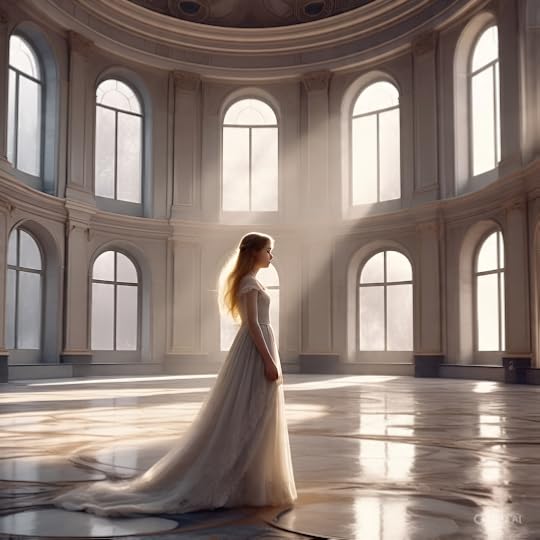
Lana took a deep breath and began digging through the pile, but most of the items she found were useless. Some thimbles and spindles seemed to have been discarded from a seamstress's workshop. There were also some sheets and curtains in clashing colors. Everything seemed hopeless until she noticed something shimmering beneath an old brown tarp. A large bolt of iridescent fabric was hidden at the bottom of the pile. She imagined how beautiful this would look hanging over the windows as the moonlight shone in. Yet, there was no way to reach the ceiling that was so high above her.
After a little digging, Lana found a rickety ladder nearby that she was able to balance against one of the walls. She secured the bolt under one arm as she climbed high above the marble floor. She secured one end of the fabric to a hook next to the first window when she realized she had no way of maneuvering herself across to the next one. Holding her breath, she attempted to balance her feet on the window frame and pull the bolt across to secure it to the next window. She was incredibly high up with no way back down unless she could reach the ladder again. Without looking down, she managed to secure the fabric all the way around the ballroom.
Finally, she made her way back around to the ladder. However, she accidentally knocked into it with the now-empty fabric bolt, causing the ladder to crash onto the ground below. The shock caused her to lose her balance, and she fell to what would surely be her death. She shrieked and squeezed her eyes shut, with her final regret of not being able to feed her family. Yet, no impact came.
When she opened her eyes, she found herself in the arms of a handsome young man.
"Are you all right?" he asked. "What were you doing up there by yourself? It's dangerous to be that high up."
"I-I needed to help my family," she stammered.
"Surely there's a safer way to do that?" The man lowered her to the ground, but she found herself clinging to his shoulders for stability.
"Lana! What on earth are you doing?" Maizie's soft voice sounded uncharacteristically harsh. "Don't you know it's a crime for servants to cavort with royalty?"
Lana glanced back at her rescuer. "Royalty?"
"It's all right," said the man. "She needed help."
"She's supposed to be here to help you, Your Highness," said Maizie.
"I'll let you get back to your work. It looks lovely," said the man as he walked away.
Lana gazed at the iridescent fabric hanging over the windows. It truly created a dazzling effect.
"You've done enough for today," huffed Maizie. "I don't ever want to see you speaking to Prince Jacob again."
"I didn't know he was the prince," Lana said, trying to defend herself.
"Likely story. I've seen lots of girls like you coming here and pretending they need work just to get close to the prince. I have a good mind to throw you out without pay."
"I'm sorry," Lana cried. "Please give me another chance."
"We'll see tomorrow."
Lana went home and helped her family cook a meager meal of soup and carrots.
The next day, she returned to the palace and was put on kitchen duty. She wasn't bad at it, but she was unfamiliar with the formal royal ingredients that royalty ate and asked a lot of questions. By the end of the day, Maizie had decided she wasn't fit for servitude and told her not to come back to help at the ball.
As she walked out through the garden, Lana saw Prince Jacob going for a stroll. Though she tried to avoid him, he called her over. She gave a polite curtsy.
"I hope I can see you at the ball tomorrow," he said.
Lana hesitated. "I'm not supposed to speak with you. Maizie said I shouldn't come back."
The prince took her hand gently in his. "She doesn't get to decide who the prince can invite as his personal guest."
Lana blushed. "But I have nothing to wear."
"What about that lovely fabric you were putting up in the ballroom?"
Lana narrowed her eyes. "That was supposed to be for the ball."
Jacob brought her to a storage room nearby. "I'm sorry. I saw them take it down last night. I thought you knew."
Lana's eyes filled with tears as she saw all her hard work in an abandoned pile in the middle of the floor. Before she realized she was crying, the prince's arms were wrapped around her.
"It doesn't all need to go to waste," he said. "It would make a lovely gown."
He helped her gather the fabric and wrap it up to bring home. When Lana's family saw her that night, they listened with excitement as she told them how kind the prince was to her and how he had invited her to the ball the following day. They helped her work all night to fashion the fabric into an exquisite gown that was finished just in time for her to go to the palace.
When the guard saw her this time, he let her in right away, thinking she was a princess from a foreign land. She entered the ballroom to find her draperies had been replaced with expensive crystals and jewels that glittered in the moonlight. She didn't see anything remotely like them in the pile Maizie had shown her when she started working there. As if summoned by her thoughts, Maizie then appeared before her.
"You!" she exclaimed. "I told you not to come back here! And you've stolen our precious fabric! I will summon the guards and have you arrested."
"Not so fast." Jacob placed his arm in front of Lana protectively. "You are not to arrest my chosen queen."
Maizie gasped. "Queen? What nonsense is this?"
He dropped to one knee before Lana. "If she'll have me."
Lana's eyes filled with tears yet again, but this time, they were tears of joy. At last, she had a way to feed her family for rest of their days and find her own happiness.
"Oh yes, of course I will!" she cried.
The guests of the ball applauded as the prince shared a dance with his new fiancee. Maizie ran off in a huff and was never seen again, but everyone else lived happily ever after.
June 12, 2025
Let's Talk About Toxic Positivity
This is not a typical discussion about an upcoming princess story, but it's still an important topic for those of us who desire to live the princess lifestyle. Princesses are generally known to be upbeat and spread happiness to those around them. While this is a wonderful trait, it can create some misconceptions about people who love princesses or want to portray them. Similar to the misconception that princesses never get angry, they are not happy all the time, nor are they unwilling to admit when something is wrong. In fact, this is a big reason why their "happily ever after" is so impactful. Pretending that everything is perfect all the time and denying the bad in any given situation can lead to toxic positivity.
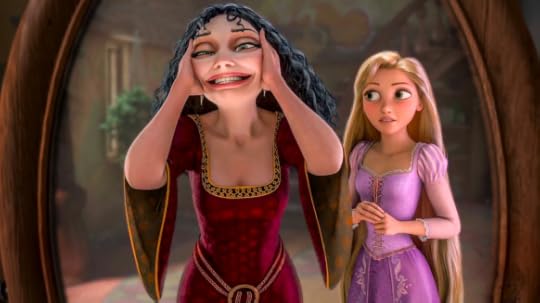
A great example of toxic positivity is Mother Gothel. By constantly reminding Rapunzel how lucky she is to be safely locked away from the world in a tower, she uses gaslighting to make Rapunzel think that there is nothing wrong with her situation. This causes Rapunzel to question her own reality and wonder if her dissatisfaction is silly and misguided. Gothel tries to convince Rapunzel that she is paranoid and negative and that she should be content with what she has. Rapunzel, who is a naturally positive person, has a hard time accepting her doubts about Gothel's treatment, but when she finally does leave the tower, she realizes that they were spot-on. This does not make her a negative person for having doubts. Instead, it makes her someone who wants to see things for what they really are.

The overdramatized sadness of earlier princesses is something that is frequently memed about with the phrase "Disney taught me that the best way to express sadness is to throw yourself on the nearest object and dramatically sob." While this is typically used for light humor, it expresses how many of us grew up learning to come to terms with our emotions. The commonality of princesses expressing negative emotions in their films is in stark contrast to the way they are portrayed at theme parks and parties, as these events are meant to inspire joy in children. My friend and I observed that if we ever mentioned anything negative to princesses we met in theme parks, they would brush it off and change the subject. This is not exactly the same as toxic positivity because they are paid professionals who are meant to have brief positive interactions with guests, but it is still a form of denying reality.
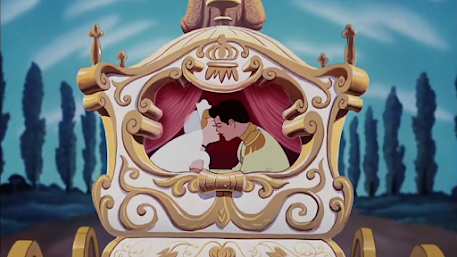
Princesses teach us that it is important to make the best of every situation and have hope for the future. However, if princess movies did not include hardships, it would lessen the impact of their joyful endings. Take Cinderella, for example. She makes the best of a toxic situation, but she never denies the reality of it. If she had allowed her stepmother to convince her that she was happy toiling day and night in her own house, she would not have cared about going to the ball. She would have told her Fairy Godmother, "No, thank you" when offered, and the movie would end with her happily scrubbing floors for the rest of her life. That's why I think it's important to see the world with open eyes and take in the bad just as much as the good. It's only when we can accept that there is a problem that we can strive to improve it. This also contributes to the trend of live-action remakes. If people keep telling Disney that they are good, we may never see a return to creative filmmaking.
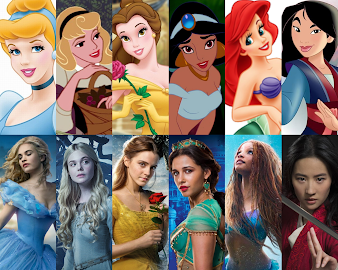 The princess archetype is often misunderstood as being perpetually happy and positive, but the stories themselves show a more nuanced reality. By acknowledging and working through challenges, princesses in stories achieve a more authentic and satisfying "happily ever after." Embracing the full range of emotions, rather than denying reality or pretending everything is perfect, allows for personal growth and meaningful connections. Embracing this complexity can lead to a more realistic and hopeful approach to life, where difficulties are acknowledged and addressed rather than denied or glossed over. Do you think toxic positivity is a problem in the real world? Let me know in the comments!
The princess archetype is often misunderstood as being perpetually happy and positive, but the stories themselves show a more nuanced reality. By acknowledging and working through challenges, princesses in stories achieve a more authentic and satisfying "happily ever after." Embracing the full range of emotions, rather than denying reality or pretending everything is perfect, allows for personal growth and meaningful connections. Embracing this complexity can lead to a more realistic and hopeful approach to life, where difficulties are acknowledged and addressed rather than denied or glossed over. Do you think toxic positivity is a problem in the real world? Let me know in the comments!
June 8, 2025
Princess Horror Movies
Thirty years ago, it would have been considered a crime to twist the sweet, gentle princess archetype into a cold-blooded murderer. Times have changed. Today, the type of violent nature required for horror movie leads is not so far off from how modern princesses act. That's why it's not too surprising that the niche fairy tale horror genre has increased in popularity over the past couple of years. In 2024 alone, there have been three gruesome, twisted princess films, two of which were based on the same fairy tale. Cinderella's Revenge, Cinderella's Curse, and The Little Mermaid all take a beloved protagonist known for her kind-hearted nature and turn her into a killer. Is there an audience for this growing trend, or is it merely a passing fad?
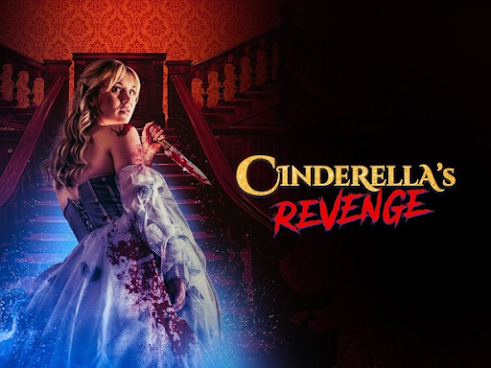
The concept of combining the traditionally family-friendly fairy tale genre with the darker, more adult horror genre is not entirely novel. Original versions of fairy tales had many dark elements before they were Disney-fied. Earlier attempts at combining the two genres, such as 1978's Beauty and the Beast and 1997's Snow White: A Tale of Terror, focused more on enhancing these elements rather than changing the nature of their protagonists. It wasn't until The Curse of Sleeping Beauty in 2016 that a movie dared to take a beloved princess and turn her into a villain. Even then, it was meant to be a shocking twist for the film's climax. Since that time, Disney's paint-by-numbers live-action remakes increased in quantity, creating a demand for more original fairy tale content that isn't a carbon copy of an animated classic. That caused the recent spike in the horror trend, which is a niche genre produced by small and independent studios due to its lack of family-friendly appeal.
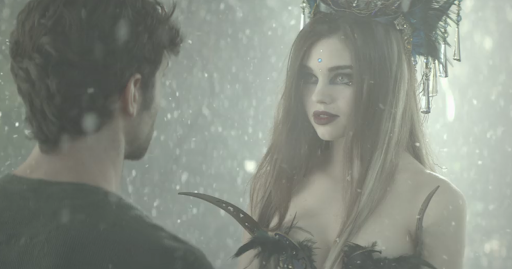
It wouldn't be a stretch to say that none of these movies hold much appeal for the majority of fairy tale and princess fans. They are not particularly beloved by fans of the horror genre either, who generally don't mix with the "family-friendly" crowd. Therefore, this niche genre is likely a passing fad meant as a way for indie filmmakers to provide something different while Hollywood experiences a dearth in creativity. For the most part, these films are painfully slow and dull due to the lack of humor or levity that Disney was known for incorporating into their adaptations. Many of them are not particularly bloody or violent and rely more heavily on the shock value of characters who are known for having impeccable morals commit unforgivable crimes than on gore. An exception to this is Cinderella's Curse, which was released by the same production studio as the infamous Blood and Honey, and is a horribly disturbing piece that showcases all the worst atrocities humans are capable of committing for practically every frame of its short runtime.
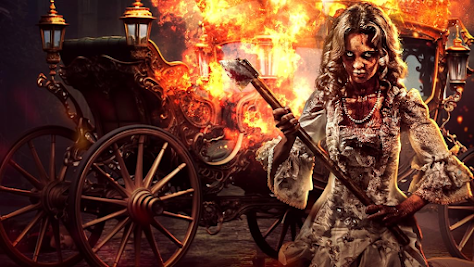
While the concept of using well-known princesses as horror movie protagonists may have been intended as an original idea, it is merely an extension of Hollywood's lazy trend to rehash pre-existing intellectual properties instead of coming up with new concepts for horror movies. Just as there are classic princesses, there are also classic horror movie characters, and little to no new ones for either genre have been created in recent years. Instead, these small niche studios are relying on the shock value of combining innocent princesses with gore, but the shock value won't last if they keep doing it. The most creative movie about princesses and murder from this decade is the Japanese 2023 movie Once Upon a Crime, which is presented as a murder mystery rather than a horror movie, making it more palatable to princess fans, who tend to have delicate sensibilities.
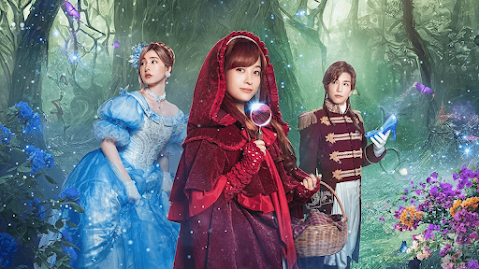
The recent surge in fairy tale horror movies, particularly those featuring beloved princesses as killers, may be a fleeting trend. While these films offer a dark twist on classic stories, they often rely on shock value rather than genuine creativity or horror. As the novelty wears off, this niche genre will likely fade, leaving room for more innovative storytelling. For now, fans of both fairy tales and horror may find themselves caught between appreciating the originality and being put off by the conflicting genres and clashing target demographics. Meanwhile, films like Once Upon a Crime show that there's potential for more nuanced explorations of princesses and crime, ones that might appeal to a broader audience.
June 6, 2025
Review: The Golden Slipper
One of my favorite things about Valia Lind is how well she develops romance in her fairy tale books. The Skazka Fairy Tales take place in a unique fantasy world built on Russian folklore that's split between the magical realm and the human realm. The Golden Slipper is a "Cinderella" retelling from this series that provides a slow-burn romance where a prince and a hard-working peasant girl fall in love over time. It does a great job of providing both perspectives and building them into realistic, fleshed-out characters. There are also a lot of great supporting characters that give the protagonist someone to turn to when she feels overwhelmed by her stepfamily. The story is brimming with magic and romance.
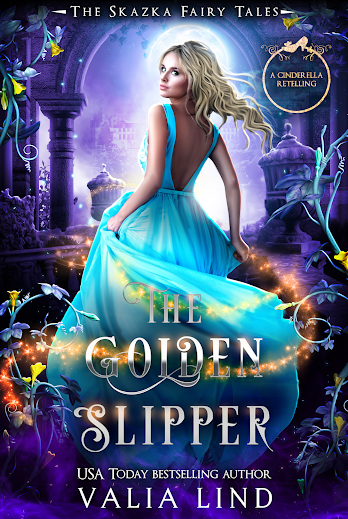
Mira is a hard worker who is skilled in many areas. She runs a flower shop and also helps her best friend, Oksana, with her bakery. Her least favorite duty is tending to her stepmother and stepsisters, who seem to be out to get her. When a clumsy young man shows up disturbing her flowers, it only makes her already difficult life even harder. Oksana helps Mira get a job at the palace to prepare for the upcoming season of balls, and Mira learns the clumsy man she insulted is none other than Prince Luca. Fortunately for her, Luca is enamored by Mira and how she doesn't treat him differently due to his royal status. When Mira's friends notice that a romance could be blossoming, they begin scheming to get her to the upcoming royal ball.
In this version of the story, Mira has several fairy godmothers helping her sneak into the ball. Her supportive friends root for her as they help her acquire the perfect gown. She received a pair of enchanted golden slippers that make her unrecognizable when she wears them, a common theme in "Cinderella" retellings. Since Luca is already in love with Mira, the magic creates an existential crisis for him because he has a hard time accepting that the mysterious princess from the ball is a different person from the prickly peasant girl who likes to speak her mind. However, this problem is easily resolved.
The final portion of the book brings back the Baba Yaga lore that is an ongoing theme in this Russian-inspired fantasy world. It creates a thrilling climax for an otherwise cozy read, but there is very little buildup to it. The burst of excitement at the end gives the book just the right push to reach a satisfying conclusion. There was also some great worldbuilding throughout the story where characters reference the human realm, showing that our world is a real place in the Skazka universe. Luca struggles with not having magic like his mother, adding depth to his personality. While Mira fits the "Cinderella" archetype, there is more to her than a mere abuse victim. She has friends and hobbies and feels like a real person.
The Golden Slipper by Valia Lind is a charming retelling of "Cinderella" that shines with its well-developed romance, relatable characters, and rich worldbuilding. The slow-burn romance between Mira and Prince Luca is a highlight, and the supporting cast adds depth and warmth to the story. While the climax feels somewhat abrupt, the book's cozy tone and satisfying conclusion make it a delightful read. Lind's unique blend of Russian folklore and fairy tale elements creates a rich and enchanting world that's worth exploring further in the Skazka series. If you're a fan of fairy tale retellings with a touch of magic and romance, The Golden Slipper is a must-read.


